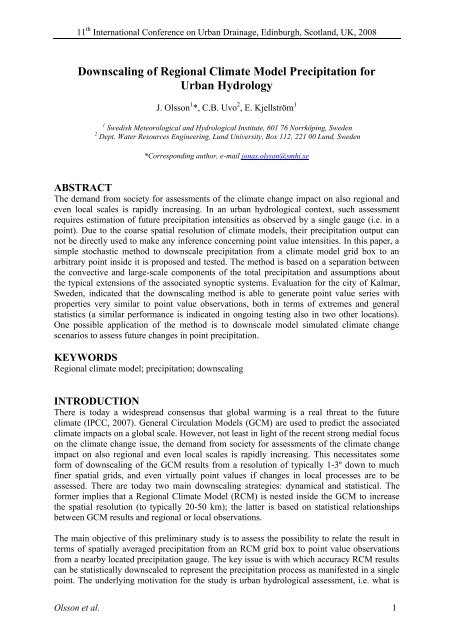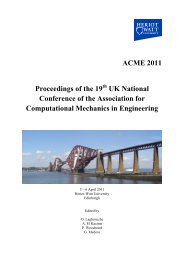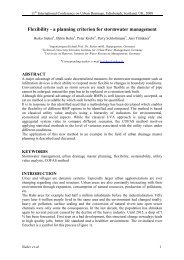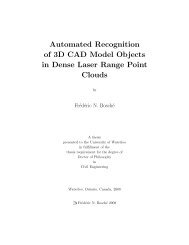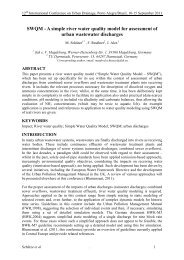Downscaling of Regional Climate Model Precipitation for Urban ...
Downscaling of Regional Climate Model Precipitation for Urban ...
Downscaling of Regional Climate Model Precipitation for Urban ...
Create successful ePaper yourself
Turn your PDF publications into a flip-book with our unique Google optimized e-Paper software.
11 th International Conference on <strong>Urban</strong> Drainage, Edinburgh, Scotland, UK, 2008<br />
<strong>Downscaling</strong> <strong>of</strong> <strong>Regional</strong> <strong>Climate</strong> <strong>Model</strong> <strong>Precipitation</strong> <strong>for</strong><br />
<strong>Urban</strong> Hydrology<br />
J. Olsson 1 *, C.B. Uvo 2 , E. Kjellström 1<br />
1 Swedish Meteorological and Hydrological Institute, 601 76 Norrköping, Sweden<br />
2 Dept. Water Resources Engineering, Lund University, Box 112, 221 00 Lund, Sweden<br />
*Corresponding author, e-mail jonas.olsson@smhi.se<br />
ABSTRACT<br />
The demand from society <strong>for</strong> assessments <strong>of</strong> the climate change impact on also regional and<br />
even local scales is rapidly increasing. In an urban hydrological context, such assessment<br />
requires estimation <strong>of</strong> future precipitation intensities as observed by a single gauge (i.e. in a<br />
point). Due to the coarse spatial resolution <strong>of</strong> climate models, their precipitation output can<br />
not be directly used to make any inference concerning point value intensities. In this paper, a<br />
simple stochastic method to downscale precipitation from a climate model grid box to an<br />
arbitrary point inside it is proposed and tested. The method is based on a separation between<br />
the convective and large-scale components <strong>of</strong> the total precipitation and assumptions about<br />
the typical extensions <strong>of</strong> the associated synoptic systems. Evaluation <strong>for</strong> the city <strong>of</strong> Kalmar,<br />
Sweden, indicated that the downscaling method is able to generate point value series with<br />
properties very similar to point value observations, both in terms <strong>of</strong> extremes and general<br />
statistics (a similar per<strong>for</strong>mance is indicated in ongoing testing also in two other locations).<br />
One possible application <strong>of</strong> the method is to downscale model simulated climate change<br />
scenarios to assess future changes in point precipitation.<br />
KEYWORDS<br />
<strong>Regional</strong> climate model; precipitation; downscaling<br />
INTRODUCTION<br />
There is today a widespread consensus that global warming is a real threat to the future<br />
climate (IPCC, 2007). General Circulation <strong>Model</strong>s (GCM) are used to predict the associated<br />
climate impacts on a global scale. However, not least in light <strong>of</strong> the recent strong medial focus<br />
on the climate change issue, the demand from society <strong>for</strong> assessments <strong>of</strong> the climate change<br />
impact on also regional and even local scales is rapidly increasing. This necessitates some<br />
<strong>for</strong>m <strong>of</strong> downscaling <strong>of</strong> the GCM results from a resolution <strong>of</strong> typically 1-3º down to much<br />
finer spatial grids, and even virtually point values if changes in local processes are to be<br />
assessed. There are today two main downscaling strategies: dynamical and statistical. The<br />
<strong>for</strong>mer implies that a <strong>Regional</strong> <strong>Climate</strong> <strong>Model</strong> (RCM) is nested inside the GCM to increase<br />
the spatial resolution (to typically 20-50 km); the latter is based on statistical relationships<br />
between GCM results and regional or local observations.<br />
The main objective <strong>of</strong> this preliminary study is to assess the possibility to relate the result in<br />
terms <strong>of</strong> spatially averaged precipitation from an RCM grid box to point value observations<br />
from a nearby located precipitation gauge. The key issue is with which accuracy RCM results<br />
can be statistically downscaled to represent the precipitation process as manifested in a single<br />
point. The underlying motivation <strong>for</strong> the study is urban hydrological assessment, i.e. what is<br />
Olsson et al. 1
11 th International Conference on <strong>Urban</strong> Drainage, Edinburgh, Scotland, UK, 2008<br />
the expected impact <strong>of</strong> climate change in terms <strong>of</strong> flooding and other problems (e.g. pollution<br />
transport) in the storm drainage network <strong>of</strong> large cities. To be accurately described by<br />
computer models, this urban run<strong>of</strong>f process requires point value precipitation data, i.e. even<br />
the spatial resolution <strong>of</strong> RCM:s is far too coarse. Also the temporal resolution required <strong>for</strong><br />
urban hydrological assessment is very high (~5-10 min), but recent RCM output is at least<br />
approaching these time scales.<br />
DATA AND STUDY REGION<br />
The regional climate model data consist <strong>of</strong> results from an RCM named RCA3, which stands<br />
<strong>for</strong> the third version <strong>of</strong> the Rossby Centre Atmospheric model (Kjellström et al., 2005). This<br />
model has been developed at the Swedish Meteorological and Hydrological Institute. The<br />
model domain covers Europe and is shown in Figure 1a. The spatial resolution <strong>of</strong> the results<br />
used here was 49×49 km and the time step 30 min. Data from grid boxes close to the<br />
observation stations (Figure 1b) were used.<br />
A general difficulty with GCM results, whether further downscaled or not, concerns their<br />
comparability with observations representing the present climate. As (1) climate exhibits lowfrequency<br />
oscillations (on decadal time scales or even longer, e.g. NAO phases) and (2) GCM<br />
runs start from arbitrary initial conditions, it is not certain that GCM results in a given time<br />
period are “in phase” with the real climate. Averaging over several decades may reduce the<br />
problem, but to which degree is difficult to assess, as is the relative contributions from “model<br />
errors” and “phase errors”. Comparing GCM-driven RCM results with observations is<br />
there<strong>for</strong>e associated with large uncertainty and requires long time series, with seldom exist <strong>for</strong><br />
short-term point precipitation observations. An alternative strategy, used in this experiment, is<br />
to drive the RCA3 model not by GCM results but by data from the ERA-40 reanalysis<br />
(Uppala et al., 2005). ERA-40 data from 60 vertical levels with resolutions 2º in space and 6 h<br />
in time were interpolated to the RCA 3 grid and then used to specify the boundary conditions<br />
<strong>for</strong> an RCA3 run. Thus the model boundary conditions were “perfect” (within the accuracy <strong>of</strong><br />
the ERA40 data set), which provides the most suitable RCA3 results <strong>for</strong> comparison with<br />
observations and reduces the need <strong>for</strong> long time periods. In this experiment, the time period<br />
used extends from the mid-80’s (when high-resolution observations started) to year 2000<br />
(when the available ERA-40-driven RCA3 data ended), i.e. covering ~15 years.<br />
<strong>Precipitation</strong> observations from single gauges in three Swedish cities (Kalmar (1), Jönköping<br />
(2), Stockholm (3); Figure 1b), representing climate regions <strong>of</strong> both maritime and more inland<br />
character, were used. The observations were obtained by tipping-bucket gauges, recording the<br />
time when 0.2 mm had accumulated, and were aggregated to 30-min values to con<strong>for</strong>m with<br />
the RCA3 output time step (Hernebring, 2006).<br />
DOWNSCALING METHODOLOGY<br />
A simple stochastic scheme was <strong>for</strong>mulated and tested <strong>for</strong> downscaling the RCA3<br />
precipitation from a grid box to possible realisations <strong>of</strong> the precipitation in a point within the<br />
box (Figure 2). The method is based on not only total precipitation from the RCA3 model, but<br />
also on its two components: large-scale and convective precipitation (which when summed<br />
adds up to the total precipitation). For each <strong>of</strong> these components, a typical spatial coverage (%<br />
<strong>of</strong> grid box) needs to be estimated. For example, as illustrated in Figure 2, the rainfall<br />
typically produced by a convective system may perhaps occupy 1/9=11% (=cc) <strong>of</strong> the grid<br />
box (~250 km² with a grid size <strong>of</strong> 49×49 km). Thus the actual precipitation intensity is 9/1=9<br />
2 <strong>Downscaling</strong> <strong>of</strong> climate model precipitation
11 th International Conference on <strong>Urban</strong> Drainage, Edinburgh, Scotland, UK, 2008<br />
a b<br />
Figure 1. RCA3 domain (Europe; a) and location <strong>of</strong> gauges (Sweden; b).<br />
times the grid box mean intensity and it has 11% probability <strong>of</strong> occurring in a certain point<br />
within the grid box. Rainfall produced by a large-scale system (e.g. strati<strong>for</strong>m), on the other<br />
hand, may typically cover 89% (=cl) <strong>of</strong> the grid box, i.e. with 89% probability producing<br />
precipitation with an intensity <strong>of</strong> 9/8=1.125 the grid box mean in a certain point (Figure 2).<br />
In this experiment the overall applicability <strong>of</strong> the proposed simple scheme was assessed and<br />
the parameters roughly optimised <strong>for</strong> the three Swedish cities. As urban hydrological<br />
modelling is critically dependent upon a proper representation <strong>of</strong> precipitation extremes, in<br />
the optimisation <strong>of</strong> the scheme the main focus was on reproducing the observed 30-min<br />
precipitation extremes as expressed in Intensity-Duration-Frequency (IDF) curves. As shortterm<br />
precipitation extremes in the region are generally produced by convective systems, the<br />
key parameter in this case is cc. The large-scale precipitation, on the other hand, governs<br />
general statistical properties <strong>of</strong> 30-min time series such as the mean 30-min volume and the<br />
wet fraction (i.e. probability <strong>of</strong> a non-zero volume). It was however found difficult to<br />
reproduce the observed general statistics by optimising cl. The reason <strong>for</strong> this was that the<br />
RCA model too frequently generates small amounts <strong>of</strong> large-scale precipitation (Räisänen et<br />
al., 2004). To compensate <strong>for</strong> this, a relatively low value <strong>of</strong> cl had to be used to get a proper<br />
wet fraction, but as a consequence the generated intensities became overestimated. There<strong>for</strong>e<br />
a different strategy was adopted, in which cl was omitted (or, equivalently, kept fixed at 1)<br />
and replaced by a threshold value tl below which all large-scale precipitation was ignored.<br />
Large-scale<br />
P<br />
Convective<br />
P<br />
Assumed coverage Actual intensity Probability in a point<br />
Figure 2. Schematic <strong>of</strong> the downscaling methodology.<br />
RCA/(8/9)=RCA*1.125 8/9 = 89% = c l<br />
RCA/(1/9)=RCA*9 1/9 = 11% = c c<br />
Olsson et al. 3<br />
2<br />
1<br />
3
11 th International Conference on <strong>Urban</strong> Drainage, Edinburgh, Scotland, UK, 2008<br />
RESULTS<br />
Figures 3-5 show some examples <strong>of</strong> results from the simple downscaling scheme, <strong>for</strong> the<br />
Kalmar gauge (nr. 1 in Figure 1b). The parameters were roughly optimised by trial-and-error<br />
and the final values obtained were cl=8% and tl=0.18 mm. All results have been averaged over<br />
10 realizations from the stochastic scheme, to obtain stable estimates<br />
Figure 3 shows the result in terms <strong>of</strong> IDF curves, return periods 15 (top left), 5 (top right), 3<br />
(bottom left) and 1 (bottom right) year(s). As expected, the short-term extremes in the grid<br />
box averages are substantially lower than in the point observations <strong>for</strong> short durations. For the<br />
maximum duration considered (1 day), however, the grid box values are in fact rather close to<br />
the observed IDF curves. Thus, at a daily scale the local (i.e. grid box) precipitation extremes<br />
simulated by the RCA3 model appear to well agree with point observations, which indicates<br />
that the RCA3 precipitation is realistic with respect to local extremes. Overall, the IDF curves<br />
obtained from the downscaled time series very well reproduce the observed curves, <strong>for</strong> all<br />
durations and return periods considered. There is a weak tendency towards underestimation,<br />
but only with a small amount.<br />
Figure 3. IDF curves <strong>for</strong> Kalmar from observed point series (solid), RCA3 grid box average<br />
series (dashed) and downscaled point series (dotted).<br />
4 <strong>Downscaling</strong> <strong>of</strong> climate model precipitation
11 th International Conference on <strong>Urban</strong> Drainage, Edinburgh, Scotland, UK, 2008<br />
Figure 4a shows the result in terms <strong>of</strong> four general statistical properties <strong>of</strong> the time series: (1)<br />
mean 30-min volume (mm), (2) standard deviation (mm), (3) mean non-zero 30-min volume<br />
(mm) and (4) probability <strong>of</strong> non-zero 30-min volume (-). For the grid box averages, the nonzero<br />
probability is substantially higher than in the observations. A higher value is expected <strong>for</strong><br />
spatial averages than <strong>for</strong> point values, but the difference is likely exacerbated by the<br />
overestimated frequency <strong>of</strong> wet 30-min periods in the RCA3 data discussed above. The mean<br />
30-min volume is also overestimated in the grid box averages but to a lesser degree. In the<br />
downscaled series, all properties are close to the observed. Figure 4b shows the<br />
autocorrelation function <strong>for</strong> lags 1-6. In the observations, the autocorrelation is ~0.5 <strong>for</strong> lag 1<br />
and then decreases to ~0.25 <strong>for</strong> lag 6. For the time series <strong>of</strong> grid box averages, the value at lag<br />
1 is ~0.8 and at lag 6 ~0.6. It is expected to have a higher autocorrelation in spatial averages,<br />
but also in this case the difference compared with the point observations is probably amplified<br />
by the inaccuracies in the RCA3 data. The erroneously generated precipitation in the RCA3<br />
model <strong>of</strong>ten occurs in the <strong>for</strong>m <strong>of</strong> long, uninterrupted sequences <strong>of</strong> similar (small) values,<br />
which increases autocorrelation. The autocorrelations in the downscaled series does not<br />
perfectly reproduce the shape <strong>of</strong> the observed function, but overall the level is very<br />
reasonable.<br />
a b<br />
Figure 4. General descriptive statistics (a) and autocorrelation functions (b) <strong>for</strong> Kalmar from<br />
observed point series (black bar, solid line), RCA3 grid box average series (grey bar, dashed<br />
line) and downscaled point series (white bar, dotted line).<br />
Figure 5 shows the result in terms <strong>of</strong> some event-related properties, mean and standard<br />
deviation <strong>of</strong> event duration (Figure 5a), event volume (Figure 5b) and length <strong>of</strong> dry period<br />
between events (Figure 5c). As expected from the results shown in Figures 3 and 4, and the<br />
associated discussion, as compared with point observations the events are longer and the dry<br />
periods shorter in the time series <strong>of</strong> grid box averages. The mean event volume is, however,<br />
well reproduces. After downscaling, also the properties <strong>of</strong> event durations are well<br />
reproduced. The dry periods lengths become somewhat overestimated though, possibly<br />
because the thresholding removes also some minor precipitation events that should have been<br />
regarded as “true”.<br />
a b c<br />
Figure 5. Statistical properties <strong>of</strong> event duration (a), event volume (b) and dry period length<br />
(c) <strong>for</strong> Kalmar from observed point series (black), RCA3 grid box average series (grey) and<br />
downscaled point series (white).<br />
Olsson et al. 5
11 th International Conference on <strong>Urban</strong> Drainage, Edinburgh, Scotland, UK, 2008<br />
CONCLUSIONS AND FUTURE WORK<br />
From this preliminary evaluation, it appears possible to combine RCM precipitation output,<br />
separated into components representing convective and large-scale precipitation, with a<br />
simple stochastic scheme reflecting spatial coverage, to create reasonably accurate realisations<br />
<strong>of</strong> the associated point rainfall process. The downscaled point precipitation series compare<br />
well with observations both in terms <strong>of</strong> general descriptive statistics and extreme values. The<br />
results support the possibility to statistically relate RCM results to short-term point<br />
observations. One possible application discussed above is to use dynamically downscaled<br />
GCM output to assess future changes in point precipitation, which however will require a<br />
very careful treatment <strong>of</strong> the calibration <strong>for</strong> present climate. However, also other applications<br />
may be envisioned, e.g. simulating point precipitation properties in ungauged areas.<br />
We believe the present methodology may constitute a step <strong>for</strong>ward in the search <strong>for</strong> tools to<br />
estimate future point precipitation. Most ef<strong>for</strong>ts to date have involved different versions <strong>of</strong> socalled<br />
delta change, where an observed rainfall time series is modified in line with changes<br />
found in RCM output. The proposed, process-based methodology is likely more flexible than<br />
delta change, which is heavily constrained by the properties <strong>of</strong> the available observations. It<br />
should however be emphasised that it is associated with uncertainty, e..g. because <strong>of</strong> the<br />
simplified descriptions <strong>of</strong> rainfall generating emchanisms in climate models.<br />
Future work will include the following activities: (1) optimisation <strong>of</strong> the coverage parameters<br />
(cc and cl) <strong>for</strong> the different cities, sensitivity testing, split sample calibration, (2) estimation <strong>of</strong><br />
coverage not as fixed areas but as given by additional RCA3 output parameters, e.g.<br />
cloudiness, (3) evaluation and optimisation <strong>for</strong> not only ERA-40-driven RCA3 results but <strong>for</strong><br />
GCM-driven RCA3 results representing present climate, (4) application <strong>of</strong> optimised<br />
downscaling scheme to GCM-driven RCA3 results representing future climate.<br />
ACKNOWLEDGEMENT<br />
The study was funded by The Swedish Research Council <strong>for</strong> Environment, Agricultural<br />
Sciences and Spatial Planning (FORMAS) and The Foundation <strong>for</strong> Strategic Environmental<br />
Research (MISTRA).<br />
REFERENCES<br />
Hernebring C. (2006). 10-års regnets återkomst förr och nu (Design storms in Sweden then and now). VA-<strong>for</strong>sk<br />
publ. 2006-04, Svenskt Vatten, Stockholm (in Swedish).<br />
IPCC (2007). <strong>Climate</strong> Change 2007: The Physical Science Basis, Summary <strong>for</strong> Policymakers. Contribution <strong>of</strong><br />
Working Group I to the Fourth Assessment Report <strong>of</strong> the IPCC<br />
Kjellström E., Bärring L., Gollvik S., Hansson U., Jones C., Samuelsson P., Rummukainen M., Ullerstig A.,<br />
Willén U. and Wyser K. (2005). A 140-year simulation <strong>of</strong> European climate with the new version <strong>of</strong> the<br />
Rossby Centre regional atmospheric climate model (RCA3). Reports Meteorology and Climatology<br />
108, SMHI, Sweden, 54 pp.<br />
Räisänen J., Hansson U., Ullerstig A., Döscher R., Graham L.P., Jones C., Meier H.E.M., Samuelsson P. and<br />
Willén U. (2004). European climate in the late twenty-first century: regional simulations with two<br />
driving global models and two <strong>for</strong>cing scenarios. Clim. Dyn., 22, 13-31.<br />
Uppala S.M., Kållberg P.W., Simmons A.J., Andrae U., da Costa Bechtold V., Fiorino M., Gibson J.K., Haseler<br />
J., Hernandez A., Kelly G.A., Li X., Onogi K., Saarinen S., Sokka N., Allan R.P., Andersson E., Arpe<br />
K., Balmaseda M.A., Beljaars A.C.M., van de Berg L., Bidlot J., Bormann N., Caires S., Chevallier F.,<br />
Deth<strong>of</strong> A., Dragosavac M., Fisher M., Fuentes M., Hagemann S., Hólm E., Hoskins B.J., Isaksen L.,<br />
Janssen P.A.E.M., Jenne R., McNally A.P., Mahfouf J.-F., Morcrette J.-J., Rayner N.A., Saunders<br />
R.W., Simon P., Sterl A., Trenberth K.E., Untch A., Vasiljevic D., Viterbo P. and Woollen J. (2005).<br />
The ERA-40 re-analysis. Quart. J. R. Meteorol. Soc., 131, 2961-3012.<br />
6 <strong>Downscaling</strong> <strong>of</strong> climate model precipitation


